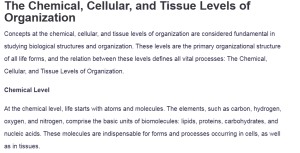The Chemical, Cellular, and Tissue Levels of Organization
Concepts at the chemical, cellular, and tissue levels of organization are considered fundamental in studying biological structures and organization. These levels are the primary organizational structure of all life forms, and the relation between these levels defines all vital processes: The Chemical, Cellular, and Tissue Levels of Organization.
Chemical Level
At the chemical level, life starts with atoms and molecules. The elements, such as carbon, hydrogen, oxygen, and nitrogen, comprise the basic units of biomolecules: lipids, proteins, carbohydrates, and nucleic acids. These molecules are indispensable for forms and processes occurring in cells, as well as in tissues.
At this level, chemical reactions, like metabolism, occur, which are essential for organisms’ energy production, growth, and repair (Chandana et al., 2024). At this level, recognizing atomic and chemical bonding that leads to compound molecules becomes the foundation for describing biological processes.
Cellular Level
Moving to the cellular level, cells constitute the most minor functional units of organisms. A cell consists of several organelles that function differently. The nucleus encapsulates genetic material, the mitochondria generate energy, and the ribosomes assemble proteins. Many processes, including cell division, gene translation, and signal transduction, occur at the single-cell level.
These cells are specialized into many types, such as muscle, nerve, and epithelial cells, which all work in coordination in carrying out general body functions (Chandana et al., 2024). Notably, research by Valls and Esposito (2022) shed light on the role of cellular signaling and interactions in the homeostasis process within the body.
Tissue Level
The tissue level is a collection of cells working harmoniously to execute a particular duty. Notably, epithelial, connective, muscle and nervous tissues are the tissue types found in the human body (Neumann & Neumann, 2021). Epithelial tissue is attached to organs both externally and internally; connective tissue provides space for development; muscular tissue provides the ability to move; and nervous tissue conducts impulses. The coordination of tissues gives rise to organs, and the integrated functioning of organs gives rise to systems like the circulatory and respiratory systems.
Learning Techniques Used
In grasping these concepts, I utilized active learning techniques, like making flashcards of key terms and processes and creating diagrams to help me picture the structure and function of each level. Further, participating in class discussions and applying these concepts to concrete examples was helpful in reinforcing this understanding.
References
Chandana, B., Syed, S. A., Khanum, S. J., Abdurahman, S., Purohit, M. N., Vishwanath, P. M., & Achar, R. R. (2024). Structures and functions of biomolecules. In Elsevier eBooks (pp. 3–19). https://doi.org/10.1016/b978-0-443-16013-4.00001-4
Neumann, P. E., & Neumann, E. E. (2021). General histological woes: Definition and classification of tissues. Clinical Anatomy, 32(6). https://doi.org/10.1002/ca.23741
Valls, P. O., & Esposito, A. (2022). Signalling dynamics, cell decisions, and homeostatic control in health and disease. Current Opinion in Cell Biology, 75(2), 102066. https://doi.org/10.1016/j.ceb.2022.01.011
ORDER A PLAGIARISM-FREE PAPER HERE
We’ll write everything from scratch
Question
Instructions
Ask a question related to the current topic that you may be struggling with. If you have mastered the material and have no questions, choose a current topic, explain it, and describe what learning techniques you used to master the material. Support your post with credible scientific source(s) in APA format (MANDATORY).

The Chemical, Cellular, and Tissue Levels of Organization
Client’s Notes:
- The topic is: the chemical, cellular, and tissue levels of organization.
Subject Area: Biology

